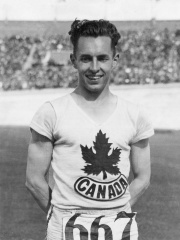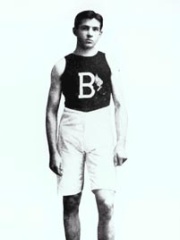







The Most Famous
ATHLETES from Canada
This page contains a list of the greatest Canadian Athletes. The pantheon dataset contains 6,025 Athletes, 480 of which were born in Canada. This makes Canada the birth place of the 6th most number of Athletes behind United Kingdom, and France.
Top 10
The following people are considered by Pantheon to be the top 10 most legendary Canadian Athletes of all time. This list of famous Canadian Athletes is sorted by HPI (Historical Popularity Index), a metric that aggregates information on a biography's online popularity. Visit the rankings page to view the entire list of Canadian Athletes.

1. Percy Williams (1908 - 1982)
With an HPI of 65.99, Percy Williams is the most famous Canadian Athlete. His biography has been translated into 27 different languages on wikipedia.
Percy Alfred Williams (May 19, 1908 – November 29, 1982) was a Canadian athlete, winner of the 100 and 200 metres races at the 1928 Summer Olympics and a former world record holder for the 100 metres sprint.

2. Jane Bell (1910 - 1998)
With an HPI of 61.86, Jane Bell is the 2nd most famous Canadian Athlete. Her biography has been translated into 22 different languages.
Florence Isabel "Jane" Bell (June 2, 1910 – July 1, 1998) was a Canadian track and field athlete who competed mainly in the 100 metres.

3. Ethel Smith (1907 - 1979)
With an HPI of 61.35, Ethel Smith is the 3rd most famous Canadian Athlete. Her biography has been translated into 27 different languages.
Ethel May Smith (July 5, 1907 – December 31, 1979) was a sprinter from Canada who won two medals at the Amsterdam 1928 Summer Olympics: a bronze medal in the 100 m, and a gold team medal in the 4 × 100 m relay. Smith was born into a poor family and quit school in the eighth grade to work at the Toronto's Garment District. She won the 220 yards at the national championships in 1927 and the 60 yards at the Ontario Championships in 1929. The same year she retired from competitions.

4. Alex Wilson (1905 - 1994)
With an HPI of 61.07, Alex Wilson is the 4th most famous Canadian Athlete. His biography has been translated into 21 different languages.
Alexander S. Wilson (December 1, 1907 – December 9, 1994) was a Canadian sprinter who competed in both the 1928 Summer Olympics and the 1932 Summer Olympics. He was born in Montreal and died in Mission, Texas, United States. In 1928 he won a bronze medal with the Canadian team in the 4 × 400 metres relay event. In the 400 metre competition as well as in the 800 metre contest he was eliminated in the semi-finals. Four years later, he won the silver medal in the 800 metre event and the bronze medal in the 400 metre competition. With the Canadian team he won another bronze medal in the 4 × 400 metre relay contest. At the 1930 British Empire Games (now the Commonwealth Games) he won the gold medal in the 440 yards event and the bronze medal in the 880 yards competition. With the Canadian relay team he won the silver medal in the 4 × 440 yards contest. He was a track and field athlete at the University of Notre Dame and the Alex Wilson Invitational was named for him because he went on to coach the track and field team for several decades. At Notre Dame he won the 400 meter NCAA Outdoor Championship in 1932. Wilson was born in Montreal, Quebec and died in Hidalgo, Texas.

5. David Hall (1875 - 1972)
With an HPI of 60.44, David Hall is the 5th most famous Canadian Athlete. His biography has been translated into 18 different languages.
David Connolly Hall (May 1, 1875 – May 27, 1972) was an American track athlete, track and basketball coach, and university professor. He served as the head basketball coach at University of Oklahoma from 1907 to 1908 and at University of Washington from 1908 to 1910. He was born in Sherbrooke, Quebec, Canada and died in Seattle. He won the bronze medal in the 800 metres track and field race at the 1900 Summer Olympics in Paris. His time in the final is unknown. The race was won by Alfred Tysoe, who had taken second in the preliminary heat which Hall had won with a time of 1:59.0. Hall also competed in the 1500 metres at the 1900 Olympics, placing fourth.

6. Douglas Bennett (1918 - 2008)
With an HPI of 59.96, Douglas Bennett is the 6th most famous Canadian Athlete. His biography has been translated into 18 different languages.
Douglas Bennett (September 13, 1918 – June 28, 2008) was a Canadian sprint canoeist who competed from the mid-1930s to the late 1940s. He won a silver medal in the C-1 1000 m event at 1948 Summer Olympics in London. Prior to becoming a canoeist, Bennett played for the Royal Montreal Hockey Club in 1937. He took up canoeing when his swimming career did not pan out. Winning several canoeing championships for Canada between 1934 and 1939, he qualified for the 1940 Summer Olympics in Tokyo that were subsequently cancelled. In 1947, Bennett was named Montreal's Sportsman of the Year after winning Canada's C-1, C-2, and C-4 national championships. Following the 1948 games, Bennett retired and went to work for Bell Canada's engineering department though he would continue canoeing for exercise. Bennett was a native of Saint Lambert, Quebec.

7. Walter Byron (1894 - 1971)
With an HPI of 59.74, Walter Byron is the 7th most famous Canadian Athlete. His biography has been translated into 17 different languages.
Jacob Walter "Wally" Byron (Jacob Valdimar Björnsson; September 2, 1894 – December 22, 1971) was an Icelandic-Canadian ice hockey player who competed in the 1920 Summer Olympics. He was the goaltender for the Winnipeg Falcons, the Canadian team that won the gold medal. He was born and died in Winnipeg, Manitoba. He was of Icelandic descent, son of Björn Bjarnarson Byron and his wife Margrét Kristmannsdóttir.

8. Earl Thomson (1895 - 1971)
With an HPI of 59.04, Earl Thomson is the 8th most famous Canadian Athlete. His biography has been translated into 23 different languages.
Earl John "Tommy" Thomson (February 15, 1895 – May 19, 1971) was a Canadian athlete, a specialist in the high hurdles. In 1920 he became the first Olympic gold medalist in 110 m hurdles from outside the United States.

9. Terry Fox (1958 - 1981)
With an HPI of 58.71, Terry Fox is the 9th most famous Canadian Athlete. His biography has been translated into 47 different languages.
Terrance Stanley Fox (July 28, 1958 – June 28, 1981) was a Canadian athlete, humanitarian, and cancer research activist. In 1980, having had one leg amputated due to cancer, he embarked on a cross-Canada run to raise money and awareness for cancer research. The annual Terry Fox Run, first held in 1981, has grown to involve millions of participants in over 60 countries and is the world's largest one-day fundraiser for cancer research; over C$900 million has been raised in his name through the Terry Fox Research Institute as of September 2024. Fox was a distance runner and basketball player for Port Coquitlam Senior Secondary School, later named after him, and Simon Fraser University. His right leg was amputated in 1977 after he was diagnosed with osteosarcoma, though he continued to run using an artificial leg. He also played wheelchair basketball in Vancouver, winning three national championships. In 1980, he began the Marathon of Hope to raise money for cancer research. He hoped to raise one dollar from each of Canada's 24 million people at the time. He began with little fanfare from St. John's, Newfoundland and Labrador, in April that year, and ran the equivalent of a full marathon every day. He had become a national star by the time he reached Ontario, and made numerous public appearances with businessmen, athletes, and politicians in his efforts to raise money. He was forced to end his run outside Thunder Bay after the cancer spread to his lungs. He died nine months later on June 28, 1981. Fox was the youngest person named a Companion of the Order of Canada and won the 1980 Lou Marsh Award as the nation's top sportsman. He was named Canada's Newsmaker of the Year in both 1980 and 1981 by The Canadian Press. Considered a national hero, he has had many buildings, statues, roads, and parks named in his honour across the country.

10. Betty Taylor (1916 - 1977)
With an HPI of 58.32, Betty Taylor is the 10th most famous Canadian Athlete. Her biography has been translated into 18 different languages.
Elizabeth Gardner Taylor (later Campbell, February 22, 1916 – February 5, 1977) was a Canadian athlete who competed in the 1932 Summer Olympics and in the 1936 Summer Olympics. She was born in Ingersoll, Ontario. In 1932 she was eliminated in the first round of the Olympic 80 metre hurdles event. Four years later she won the bronze medal in the 80 metre hurdles competition. She won the silver medal in the 80 metre hurdles contest at the 1934 Empire Games and as well at the 1934 Women's World Games.
People
Pantheon has 480 people classified as Canadian athletes born between 1873 and 2005. Of these 480, 424 (88.33%) of them are still alive today. The most famous living Canadian athletes include Peter Kirby, Archibald MacKinnon, and Francisco Fernández. The most famous deceased Canadian athletes include Percy Williams, Jane Bell, and Ethel Smith. As of April 2024, 70 new Canadian athletes have been added to Pantheon including Devon Larratt, Kevin Neufeld, and Bruce Robertson.
Living Canadian Athletes
Go to all RankingsPeter Kirby
1931 - Present
HPI: 56.47
Archibald MacKinnon
1937 - Present
HPI: 53.28
Francisco Fernández
HPI: 53.06
Hayley Wickenheiser
1978 - Present
HPI: 52.16
Andre De Grasse
1994 - Present
HPI: 50.45
Vic Emery
1933 - Present
HPI: 49.82
Nelson Kuhn
1937 - Present
HPI: 49.10
Myriam Bédard
1969 - Present
HPI: 48.94
Devon Larratt
1975 - Present
HPI: 48.75
Brianne Theisen-Eaton
1988 - Present
HPI: 48.56
Marc-André Fleury
1984 - Present
HPI: 47.43
Lynn Williams
HPI: 46.88
Deceased Canadian Athletes
Go to all RankingsPercy Williams
1908 - 1982
HPI: 65.99
Jane Bell
1910 - 1998
HPI: 61.86
Ethel Smith
1907 - 1979
HPI: 61.35
Alex Wilson
1905 - 1994
HPI: 61.07
David Hall
1875 - 1972
HPI: 60.44
Douglas Bennett
1918 - 2008
HPI: 59.96
Walter Byron
1894 - 1971
HPI: 59.74
Earl Thomson
1895 - 1971
HPI: 59.04
Terry Fox
1958 - 1981
HPI: 58.71
Betty Taylor
1916 - 1977
HPI: 58.32
Duncan McNaughton
1910 - 1998
HPI: 56.81
Doug Rogers
1941 - 2020
HPI: 56.69
Newly Added Canadian Athletes (2025)
Go to all RankingsDevon Larratt
1975 - Present
HPI: 48.75
Kevin Neufeld
1960 - 2022
HPI: 46.76
Bruce Robertson
1962 - Present
HPI: 45.92
Brian McMahon
1961 - Present
HPI: 45.25
Michael Rascher
1965 - Present
HPI: 45.11
Nathalie Lambert
1963 - Present
HPI: 44.85
Terrence Paul
1964 - Present
HPI: 44.63
Theresa Luke
1967 - Present
HPI: 43.74
Guillaume LeBlanc
1962 - Present
HPI: 43.52
Lynn Kanuka-Williams
1960 - Present
HPI: 43.31
Marcia Gudereit
1965 - Present
HPI: 43.16
Dave Boyes
1964 - Present
HPI: 43.05
Overlapping Lives
Which Athletes were alive at the same time? This visualization shows the lifespans of the 25 most globally memorable Athletes since 1700.


























